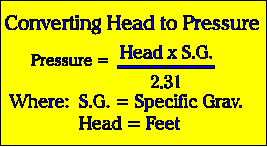
Lesson One - What is a Centrifugal Pump?
Contents
- Developing Kinetic Energy
- Pressure is Resistance to Flow
- Head
- Converting Head to Pressure
- Impeller Diameter and RPMs
Developing Kinetic Energy
A centrifugal pump is a device which converts driver energy to kinetic energy in a liquid by accelerating it to the outer rim of a revolving device known as an impeller. The key idea here is that the energy created is kinetic energy. The amount of energy given to the liquid corresponds to the velocity at the edge or vane tip of the impeller.The faster the impeller revolves or the bigger the impeller is, then the higher will be the velocity of the liquid at the vane tip and the greater the energy imparted to the liquid.
Pressure is an Indication of Resistance to Flow
The kinetic energy of a liquid coming out of an impeller is harnessed by creating a resistance to the flow. The first resistance is created by the pump volute (casing) which catches the liquid and slows it down. When the liquid slows down in the pump casing some of the kinetic energy is converted to pressure energy. It is the resistance to the pump’s flow that is read on a pressure gauge attached to the discharge line.
Note!!! A pump does not create pressure, it only creates flow! Pressure is a measurement of the resistance to flow.
Head
In newtonian fluids (non-viscous liquids like water or gasoline) we use the term head to measure the kinetic energy which a pump creates. Head is a measurement of the height of a liquid column which the pump could create resulting from the kinetic energy the pump gives to the liquid (imagine a pipe shooting a jet of water straight up into the air, the height the water goes up would be the head). The main reason for using head instead of pressure to measure a centrifugal pump’s energy is that the pressure from a pump will change if the specific gravity (weight) of the liquid changes, but the head will not change. So we can always describe a pump’s performance on any newtonian fluid, whether it’s heavy (sulfuric acid) or light (gasoline) by using the term head.
Remember, head is related to the velocity which the liquid gains when going through the pump.
Converting Head to Pressure
To convert head to pressure the following formula applies:

Newtonian liquids have specific gravities typically ranging from 0.5 (light, like light hydrocarbons) to 1.8 (heavy, like concentrated sulfuric acid). Water is a benchmark, having a specific gravity of 1.0.
Return to Table of Contents
Return to Top of Lesson One
Impeller Diameter and RPM
The two main factors in determining how much head a pump creates are:
The Impeller Diameter
The RPM of the Impeller (revolutions per minute)
Impeller Diameter
If the speed (revolutions per minute) of the impeller remains the same then the larger the impeller diameter the higher the generated head. Note that as you increase the diameter of the impeller the tip speed at the outer edge of the impeller increases commensurately. However, the total energy imparted to the liquid as the diameter increases goes up by the square of the diameter increase. This can be understood by the fact that the liquid’s energy is a function of its velocity and the velocity accelerates as the liquid passes through the impeller. A wider diameter impeller accelerates the liquid to a final exit velocity greater than the proportional increase in the diameter.
RPMs (Revolutions Per Minute)
As the number of revolutions per minute of an impeller increases, the velocity (and head) imparted to the liquid passing through it increases as well. As the impeller revolves more rapidly the rate of increase in the liquid velocity is higher than the rate of rpm increase. In other words, an impeller spinning at 2000 RPMs generates more than twice the head of the same impeller spinning at 1000 RPMs.
Contents
- Developing Kinetic Energy
- Pressure is Resistance to Flow
- Head
- Converting Head to Pressure
- Impeller Diameter and RPMs
Developing Kinetic Energy
A centrifugal pump is a device which converts driver energy to kinetic energy in a liquid by accelerating it to the outer rim of a revolving device known as an impeller. The key idea here is that the energy created is kinetic energy. The amount of energy given to the liquid corresponds to the velocity at the edge or vane tip of the impeller.The faster the impeller revolves or the bigger the impeller is, then the higher will be the velocity of the liquid at the vane tip and the greater the energy imparted to the liquid.
Pressure is an Indication of Resistance to Flow
The kinetic energy of a liquid coming out of an impeller is harnessed by creating a resistance to the flow. The first resistance is created by the pump volute (casing) which catches the liquid and slows it down. When the liquid slows down in the pump casing some of the kinetic energy is converted to pressure energy. It is the resistance to the pump’s flow that is read on a pressure gauge attached to the discharge line.
Note!!! A pump does not create pressure, it only creates flow! Pressure is a measurement of the resistance to flow.
Head
In newtonian fluids (non-viscous liquids like water or gasoline) we use the term head to measure the kinetic energy which a pump creates. Head is a measurement of the height of a liquid column which the pump could create resulting from the kinetic energy the pump gives to the liquid (imagine a pipe shooting a jet of water straight up into the air, the height the water goes up would be the head). The main reason for using head instead of pressure to measure a centrifugal pump’s energy is that the pressure from a pump will change if the specific gravity (weight) of the liquid changes, but the head will not change. So we can always describe a pump’s performance on any newtonian fluid, whether it’s heavy (sulfuric acid) or light (gasoline) by using the term head.
Remember, head is related to the velocity which the liquid gains when going through the pump.
Converting Head to Pressure
To convert head to pressure the following formula applies:

Newtonian liquids have specific gravities typically ranging from 0.5 (light, like light hydrocarbons) to 1.8 (heavy, like concentrated sulfuric acid). Water is a benchmark, having a specific gravity of 1.0.
Return to Table of Contents
Return to Top of Lesson One
Impeller Diameter and RPM
The two main factors in determining how much head a pump creates are:
The Impeller Diameter
The RPM of the Impeller (revolutions per minute)
Impeller Diameter
If the speed (revolutions per minute) of the impeller remains the same then the larger the impeller diameter the higher the generated head. Note that as you increase the diameter of the impeller the tip speed at the outer edge of the impeller increases commensurately. However, the total energy imparted to the liquid as the diameter increases goes up by the square of the diameter increase. This can be understood by the fact that the liquid’s energy is a function of its velocity and the velocity accelerates as the liquid passes through the impeller. A wider diameter impeller accelerates the liquid to a final exit velocity greater than the proportional increase in the diameter.
RPMs (Revolutions Per Minute)
As the number of revolutions per minute of an impeller increases, the velocity (and head) imparted to the liquid passing through it increases as well. As the impeller revolves more rapidly the rate of increase in the liquid velocity is higher than the rate of rpm increase. In other words, an impeller spinning at 2000 RPMs generates more than twice the head of the same impeller spinning at 1000 RPMs.